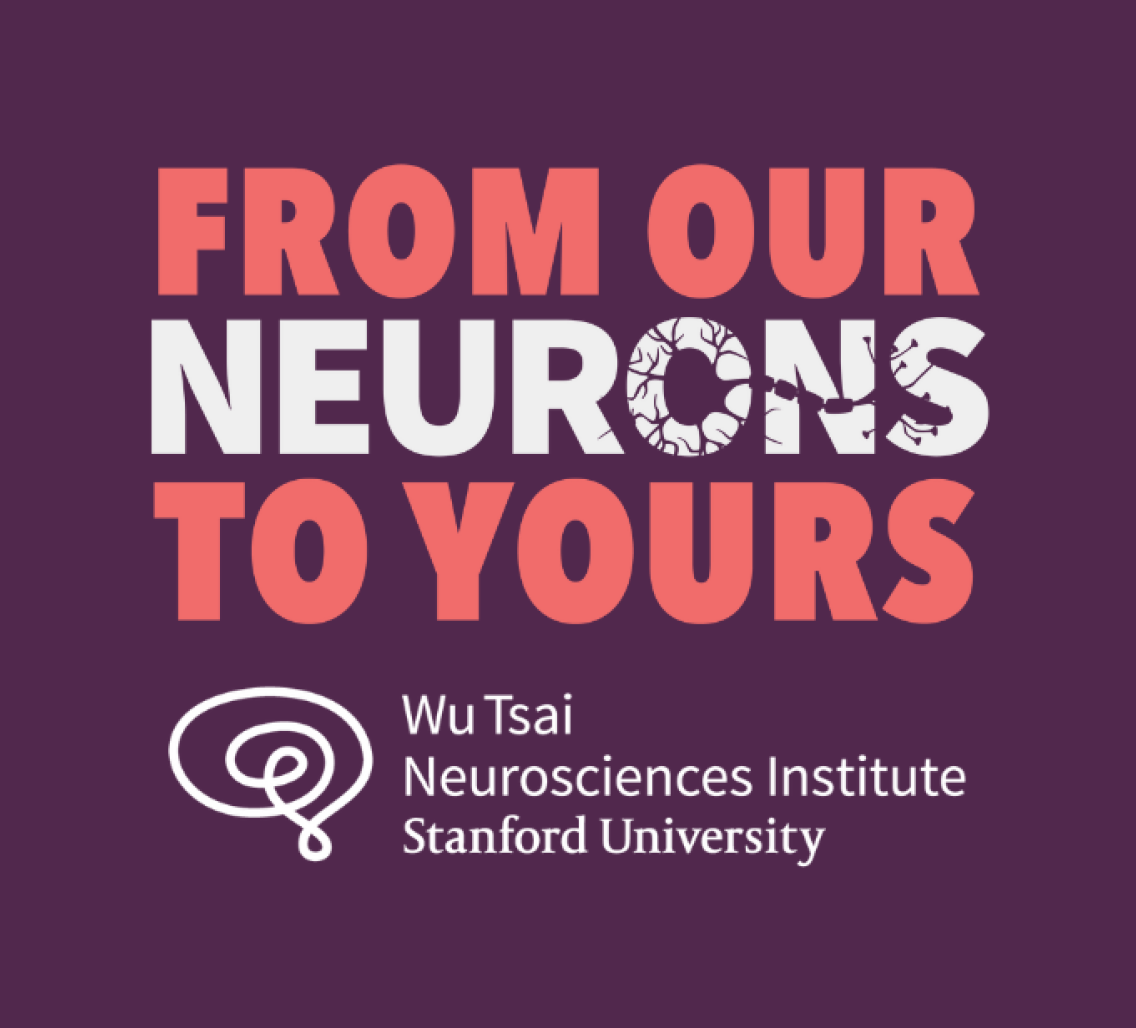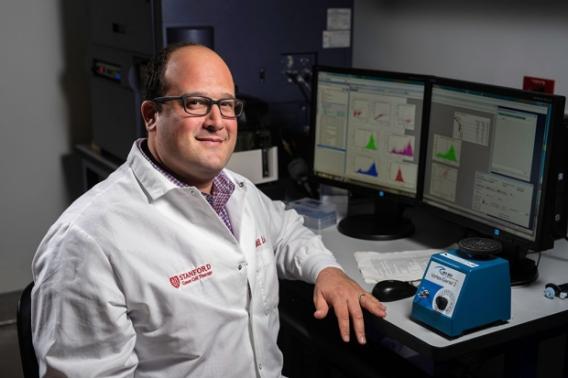How the brain helps cancers grow

Today, we're talking with Stanford neuro-oncologist, Michelle Monje. This is actually the third time we've had Michelle on the show, in part because she's been a pioneer of three exciting frontiers in neuroscience — so far!
This week, we're going to talk about cancer neuroscience. Michelle founded this new field with her discovery that deadly brain tumors not only link up physically with the healthy brain tissue surrounding them, but that cancers actually need the brain's electrical activity to grow and spread.
It turns out that many cancers — not only in the brain — depend on nervous system innervation for their survival. Understanding this dependent relationship better may present an exciting new line of attack for oncology.
Join us to learn more!
SUBSCRIBE on Apple Podcasts, Spotify, Amazon Music and more.
Learn more
News coverage
- Brain tumors caused by normal neuron activity in mice predisposed to such tumors
- Brain tumors form synapses with healthy neurons, Stanford-led study finds
- Deadly brain cancers act like 'vampires' by hijacking normal cells to grow
- Engineered immune cells target broad range of pediatric solid tumors in mice
Relevant Publications
- Glioma synapses recruit mechanisms of adaptive plasticity
- Glioblastoma remodelling of human neural circuits decreases survival
- Electrical and synaptic integration of glioma into neural circuits
- Targeting neuronal activity-regulated neuroligin-3 dependency in high-grade glioma
- Neuronal Activity Promotes Glioma Growth through Neuroligin-3 Secretion
Review Articles
- The neuroscience of cancer
- Cancer hallmarks intersect with neuroscience in the tumor microenvironment
- Roadmap for the Emerging Field of Cancer Neuroscience
Episode Credits
This episode was produced by Michael Osborne at 14th Street Studios, with production assistance by Morgan Honaker. Our logo is by Aimee Garza. The show is hosted by Nicholas Weiler at Stanford's Wu Tsai Neurosciences Institute.
If you're enjoying our show, please take a moment to give us a review on your podcast app of choice and share this episode with your friends. That's how we grow as a show and bring the stories of the frontiers of neuroscience to a wider audience. You can also send us an email at neuronspodcast@stanford.edu.
Episode Transcript
Nicholas Weiler:
This is From Our Neurons to Yours, a podcast from the Wu Tsai Neurosciences Institute at Stanford University, bringing you to the frontiers of brain science.
Today, we're talking with Stanford neuro-oncologist, Michelle Monje. This is actually the third time we've had Michelle on the show, in part because she's been a pioneer of three exciting frontiers in neuroscience so far. Michelle, we're waiting on number four. We talked in our first season about what we are learning about the brain fog that sometimes follows chemotherapy or infection with viruses like COVID-19. And we talked with her earlier this year about her discovery that the insulating myelin that wraps nerve fibers can change in response to brain activity, altering the timing of brain signals and potentially playing a role in the persistence of addiction.
This week, we're going to talk about the new field of cancer neuroscience that Michelle founded with her discovery that deadly brain tumors not only link up physically with the healthy brain tissue surrounding them, they need its electrical activity to grow and spread.
This disturbing finding could actually have some promising implications, and not only for brain tumors. Following Michelle's discovery, other researchers are finding that most, if not all cancers, also depend on nervous system innervation for their survival, which, if we understand it better, may present an exciting new line of attack for oncology.
Michelle specializes in a type of cancer called diffuse midline glioma, which arises from the brain's glial support cells. These cancers arise in early childhood in the brain stem thalamus or spinal cord. They don't respond well to chemotherapy and they can't be removed surgically due to their locations deep in the brain. They are universally fatal.
I started our conversation asking Michelle to describe her first encounter with a patient with one of these tumors and how it sparked her interest in the neuroscience of cancer.
Michelle Monje:
So I started to really focus on these tumors when I first took care of a child, was an eight-year-old girl who I cared for when I was a medical student. And I just couldn't believe there was anything this awful. I mean, we knew nothing about, really, nothing beyond that this is the most common form of high-grade glioma in childhood. And it's always lethal, typically within a year. And I just felt that, given this pattern that the different kinds of high-grade gliomas happen in different places of the nervous system at different ages, that it was really a disease of dysregulated neurodevelopment, and that we neuroscience to understand it. And so I thought, "I can't turn away from this. I have to study it.", and have been studying it since that time. Over the last great number of years that I've been focusing on this tumor, we've discovered that this kind of brain cancer arises from precursor cells in the oligodendroglia lineage, so precursors to myelin-forming glia.
Nicholas Weiler:
And we've talked about myelin before. We've talked about it in the context of brain fog, in long COVID the first time we spoke, and we talked about it again in your work studying how myelin changes dependent on brain activity. And so now you're seeing another role of myelin here during brain development in these terrible cancers.
Michelle Monje:
Yeah. And since we're talking about the history of this journey, that's where I started. So I focused on these tumors. I discovered as a postdoctoral fellow that the oligodendrocyte precursor cell was the most likely cell of origin for these kinds of cancers. That's something that both my laboratory and many others in the field have now further confirmed. And I started studying myelin in response to that. So I thought we need to understand what regulates these myelin-forming precursors in the postnatal brain. Under normal conditions, what regulates in the healthy nervous system? Myelin develops over about 30 years of human development.
And I wanted to understand it and understand what influenced it, and how this protracted process might be susceptible to various challenges during childhood and adolescence, how it might even be plastic and adaptable to experience, something we now understand to be true and how that might contribute in the healthy nervous system to various brain functions. And on the other side, how disrupting the development of myelin, the plasticity of myelin, might contribute to diseases like cancer therapy-related cognitive impairment. And finally, how cancers that very closely resemble normal oligodendroglial precursors could be hijacking some of those mechanisms that are meant for development and plasticity. And so my journey in cancer neuroscience actually really started with the understanding that we needed to understand much more about the basic biology of this cancer and how it arises and what drives both the normal precursors and then how the cancer is utilizing those processes for ill.
Nicholas Weiler:
And so it was just a few years ago that you then discovered that not only are these cancers arising in the brain from these myelin-generating cells, but they're also actually interacting directly with brain circuits.
Michelle Monje:
Exactly. So when I started my laboratory in 2011, it was with the idea that I would ask two parallel questions. One, how does neuronal activity regulate normal myelin-forming cells? And then how do these oligodendroglial lineage-derived childhood brain cancers respond to neuronal activity? How might they be hijacking what I hypothesized was a very powerful set of interactions? And what we discovered in the realm of how the cancer is responding is that, just like their normal counterparts, these glial malignancies, both of childhood and of adulthood, grow and proliferate in response to the activity of the nervous system. And the first set of mechanisms that we discovered relevant to this activity-dependent brain cancer growth were paracrine factors, activity-regulated growth factors like neurotrophins, and also some really surprising factors regulated by neuronal activity that promote the growth of gliomas.
And what we found was that those interactions, they didn't just stimulate proliferation and growth, they seemed to be required for it. So that was unexpected. When we blocked these signals, the tumors didn't just slow down, they just stopped. And I felt we didn't understand enough to explain that. We hypothesized that the tumors might actually be making functional synapses with neurons when we discovered that an activity-regulated factor that we had previously been studying as a paracrine factor caused upregulation of synapse-associated genes in the tumor cells. And so we examined whether there might be real synapses that are forming. First we did electron microscopy, and we saw really clear evidence of lots of synapses in primary patient tumor samples, but we didn't know in the primary samples whether the postsynaptic cells we were seeing and whether those were the cancer cells or some normal cell type.
And so we then did electron microscopy in experimental models where we can immunogold label the tumor cells. And then we saw very clearly that there are true synaptic structures with presynaptic neurons and postsynaptic cancer cells. And we had to ask then, "Is this just sort of the shadow of the cell type from which we believe these tumors arise? Or might there actually be some electrophysiologically functional synapses occurring in this cancer?" And we collaborated at the time with Rob Malenka's lab and found that, indeed, they exhibit postsynaptic currents. They have AMPA receptor-dependent synapses, and that if we block that either pharmacologically or genetically in the tumor cell, that was profoundly therapeutic in mouse models.
Nicholas Weiler:
So these tumors are receiving the signals and they need to receive the signals for their continued pathology.
Michelle Monje:
And they need to receive the signals, exactly.
Nicholas Weiler:
Yeah.
Michelle Monje:
And we later found that the tumors not only have AMPA receptor-mediated synapses, but they exhibit synaptic plasticity through classical postsynaptic plasticity mechanisms-
Nicholas Weiler:
Yeah.
Michelle Monje:
... in response to other activity-regulated factors. They increase the trafficking of AMPA receptors to the postsynaptic membrane to change the strength of the glutamatergic current.
Nicholas Weiler:
That's so wild.
Michelle Monje:
It's wild. And you can visualize it with genetically encoded calcium indicators. These are electrically active cells. This is an electrically active tissue, these cancers. That matters for their progression. So we wondered whether membrane depolarization itself might be important to the cancer. Why is this tumor undergoing what is really a very metabolically expensive thing to do to undergo membrane and repolarization?
Nicholas Weiler:
Yeah. What do the cancers get out of it, I guess is the question.
Michelle Monje:
Yeah, yeah, exactly. So we tested that and we said, "What if we just experimentally depolarize the tumor cell?" So we used optogenetics to do that, and we found that just the membrane depolarization increased the growth of the cancer. And that makes some sense. When you think back at what we know about brain development, neural stem and precursor cell populations undergo synchronous waves of membrane depolarization thought to regulate their proliferation and differentiation. So there's some voltage-sensitive intracellular signaling cascades that are important for neural stem and precursor cell proliferation, or differentiation in health, that are likely being hijacked here. And we're working hard to understand what those intracellular consequences are of membrane depolarization. But it's very clear from our experimental manipulations that membrane depolarization drives growth and the degree of membrane depolarization drives growth. The larger the depolarizing current, the more it causes tumor cell proliferation.
Nicholas Weiler:
Wow. And so this has been replicated in a number of different cancers. After you made this first observation-
Michelle Monje:
Yeah.
Nicholas Weiler:
... People have now seen that this is not just true of brain cancers, it's true of cancers across the body. They all need, well, many cancers need nervous system innervation. And this has even been proposed now, I think, in a review article that you were involved in as a fundamental pillar of cancer biology.
Michelle Monje:
That's right. It has really been exciting to be part of this from the beginning. It turns out that just as innervation is critical for development, not only of the nervous system, but also of organs throughout the body and for maintenance of stem cell niches, for regeneration, innervation is critically important for cancers. And the same principles of activity-dependent cancer growth, it's evident across cancers as diverse as breast, prostate, colon, stomach, lung, pancreas, and skin cancers.
Nicholas Weiler:
And so there you don't have the argument that it's just leftover of the fact that these brain tumors are originating from nervous system tissue. These are cancers originating from different tissue types, but they all need this nervous system innervation as well.
Michelle Monje:
Yeah, that's right. The similar concept, though, is that innervation is critically important not only for nervous system function, but actually for the function of organs throughout the body, and also required for the development of organs throughout the body. So there's a beautiful set of studies from Sarah Knox's lab showing that glandular organ development depends upon appropriate cholinergic innervation. And then it stands to reason that the same kind of nerve stem cell niche interactions might be hijacked in the context of various glandular cancers. And that has shown to be true. And I think it's important to remember that peripheral nerves are really important for maintaining the stem cell niche throughout the body in every tissue. And so cancers of those tissues similarly seem to depend really profoundly on those same nervous system interactions. And so it's been very exciting to see this new branch of oncology, cancer neuroscience, evolve and become so clearly an [inaudible 00:12:27] of oncology.
Nicholas Weiler:
And so given that this appears to be a very general feature of all or most cancers, what does this suggest to you as far as new opportunities for cancer treatment? I mean, it's always exciting to discover something that cancers depend on because then we can try to take it away.
Michelle Monje:
Exactly, exactly. And that's what I'm most excited about, that as we understand the granular details of these nervous system cancer interactions in various tumor types, we can disrupt them. And while that might not be sufficient to treat the cancer, it actually might be necessary. And so I think that there is this additional dimension of therapy for cancers that we've been missing for a number of years and that are really important to discover and begin to use, especially for the most difficult to treat cancers. So just as we've discovered that disrupting neuron glioma interactions is very promising and clinical trials have opened and are opening to try to target these interactions, the same is happening for cancers throughout the body.
For example, use of beta blockers to disrupt adrenergic signals to pancreatic cancer and to breast cancer. There are trials opening to see how disrupting this very important growth-promoting and tumor-maintaining signaling relationship might augment existing therapies. And I think as we discover more and more about what they are and how we can disrupt them, we not only can add additional therapies that may improve outcomes for patients with various kinds of cancers, but we may in fact be able to repurpose a number of different existing medications.
Nicholas Weiler:
So medications that we've developed for the nervous system maybe now have an effect on cancer.
Michelle Monje:
Yeah. Medicines that we've developed broadly for excitable tissue. So there are medicines in cardiology, in neurology, in psychiatry, in pain management, all of which may have roles in very specific tumor contexts, but knowing the details matter. So the same nervous system cancer interaction that in one tumor type is beneficial, it might be disadvantageous in another tumor type. And it's important to understand the granular details of the ion tunnel physiology and the neuroscience of each cancer because we've identified some medicines that actually can augment tumor growth and that are commonly given to patients for different indications. So it's really important to know not only what is helpful to give to disrupt these interactions, but also for that tumor type what medications potentially need to be avoided.
Nicholas Weiler:
Yeah. I mean, I was listening to a conversation you had on another podcast as I was thinking about this topic. And I was struck by something that you said about a unifying theme of a lot of this work and the other conversations we've had in the past is needing to better understand how different groups of cells are talking to each other, needing to understand how neurons are talking to these cancer cells or how myelin-producing cells are talking to neurons and vice versa. So it must be really gratifying to have come from seeing these patients, realizing that there was so much we didn't know, devoting yourself to understanding these interactions, and now seeing that not only does this potentially have the capacity to help us understand and treat those cancers, but also potentially all cancers.
Michelle Monje:
Thank you. It's really been quite exciting to be part of this path of inquiry. I do think we're moving in a really positive way towards understanding what we need to offer better therapies to patients with difficult to treat cancers. And I think, not only because I'm a neuroscientist, I think that the nervous system is important, but I think that it is increasingly undeniable that the nervous system is really important in a range of physiologies that we hadn't previously considered its role. So not only in cancer, but also in immunology. We know that there's just critical crosstalk between the nervous system and many other kinds of cells in the body.
Nicholas Weiler:
Well, that's so interesting. I think a lot about what are the ways in which our bodies inform our mental states? But our brain is, it's regulating things all across the body in interesting ways. My understanding is that the cancers are getting synapses from neurons and depend on neural activity. I just wanted to clarify, there isn't evidence that the cancers are contributing to neural circuit activity, or has that been shown?
Michelle Monje:
So the interactions between gliomas and neurons are bidirectional in some ways. So just as neural activity drives cancer growth, both through these secreted growth factors but also direct neuron to glioma synaptic communication, the tumor cells influence the excitability of neurons and actually contribute to functional remodeling of neural circuits. What we don't have any evidence for is any electrophysiological signaling between the cancer and the neuron. So there are no synapses that are starting on the glioma side and ending on the neuron side. So there are no presynaptic glioma cells. Gliomas don't have action potentials as far-
Nicholas Weiler:
Right.
Michelle Monje:
... as we can tell. But they profoundly influence the function of neurons through multiple mechanisms. This contributes to glioma-associated seizures. It increases the excitability clearly of neural circuits. But more recently, work from Shawn Hervey-Jumper's lab at UCSF showed that gliomas functionally remodel neural circuits in patients. And he is a neurosurgeon who does incredible intraoperative electrocorticography and records from his patients prior to resecting their tumors.
And what he did was he had his patients perform language tasks, both visual and verbal naming tasks, so expressive language tasks. And he found that in patients who had left-sided high-grade gliomas, that when the patients engaged in this expressive language task, that it wasn't just expressive language areas that were recruited, but the entirety of the tumor-infiltrated cortex, so that the tumor had functionally remodeled left hemispheric cortex such that expressive language triggered activity throughout the tumor-infiltrated brain, thereby increasing the signals between the brain and the tumor every time the patient formed language.
And it's these kinds of augmenting mechanisms to increase neuronal activity and to increase the inputs into the tumor that would be advantageous to tumor growth because we know there are these activity-dependent mechanisms. And what he found was that the more functionally connected the tumor was to the rest of brain, the worse the patient's prognosis, the shorter that patient survived. And so we have evidence now from not just experimental models, but also from patients that these interactions, which are bidirectional in many ways, are really fundamental to tumor progression and must be targeted therapeutically. I don't think we will be able to cure these kinds of very aggressive brain cancers without targeting these incredibly powerful communication between neurons and the cancer cells.
Nicholas Weiler:
Yeah. I mean, I guess this is true for all cancers that cancer is self, right? It's your own cells that are selfishly taking up resources and becoming sort of parasitic on the rest of the body. But it feels, in some ways, more personal when it's the brain. I don't know.
Michelle Monje:
It does.
Nicholas Weiler:
It's irrational, but it's true, at least for me. So we're out of time now, but it's been such a pleasure learning from you and learning about the ways in which we are moving towards new understanding and new treatments for these terrible diseases. And we didn't even get a chance to talk about the fact that you're doing incredible work in immunotherapy that's shown fantastic results for these patients. And we'll certainly link to some stories about that in the show notes. But thank you so much for the work you're doing, and thank you for coming on the show.
Michelle Monje:
Oh, thank you, Nick. It was great to talk to you.
Nicholas Weiler:
Thanks again so much to our guest, Michelle Monje. She's Milan Gambhir professor of pediatric neuro-oncology in the Stanford Department of Neurology. To read more about her work, check out the links in the show notes.
If you're enjoying the show, please subscribe and share with your friends. It helps us grow as a show and bring more listeners to the frontiers of neuroscience. We'd also love to hear from you. Tell us what you love or what you hate about the show in a comment on your favorite podcast platform, or send us an email directly at neuronspodcast@stanford.edu.
From Our Neurons to Yours is produced by Michael Osborne at 14th Street Studios, with production assistance from Morgan Honecker. I'm Nicholas Weiler. Until next time.




